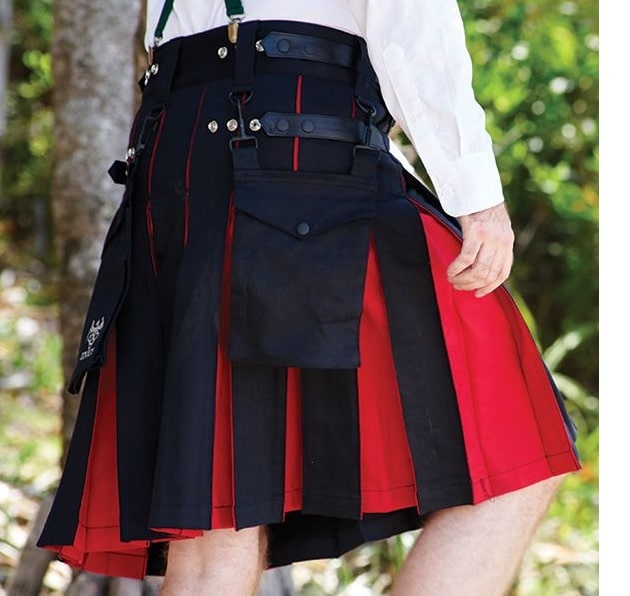Kilts and utility kilts are such a vibrant fashion option, but unlike your normal clothing, if you treat it with a little extra care, doing, so it will last a long time and require minimal effort.

After you’ve worn your kilt, it is always good practice to give it a close inspection to make sure there aren’t any spills on it, check if it’s damp, and lint free. You wouldn’t want a mouldy and mildew ridden kilt the next time you pull it out to wear it.
This becomes more critical if you go months between uses, the problem can only get worse over time when caring and cleaning your kilt with our guide below is actually quite simple.
With that in mind, we want to share essentials in simple kilt maintenance and way to keep your kilt clean, all while helping them to last as long as possible.
Clean Your Utility Kilt Well.
Similar to your other pieces of clothing, having a clean kilt extends its service life for years to come. If it has come to the point where you feel it needs washing, can you simply toss it in the washer and dryer? Well, not exactly.
Here are some pointers in cleaning your kilt the right way.
1. Don’t Fast Wash Your Kilt.
As it suggests, quick washing usually takes around 15 minutes to an hour using your washing machine. Though you may think it’s convenient when washing lightly soiled or small amounts of clothing, for specialised clothing such as a kilt, it’s best to use a different option.
Note that kilts have clips, buckles and other accessories that can get tangled during fast washing. If you feel it needs a machine wash, we recommend doing so using cold water and setting the machine on a delicate or gentle cycle, and ideally, without a fast spin cycle.
Ensure that its belt and buckles are undone, so they don’t catch on the wash drum or twist the garment. After washing, NEVER, EVER WRING YOUR KILT.
We suggest once washed, laying it out flat, then lining up all the pleats on a large flat surface, as you go just gently hand pressing out any creases. Once done, carefully hang your kilt up from the belt line while unfurled. Some even just lay them out to dry slowly and naturally. Just be careful with trapped moisture, and NEVER put your kilt over a heater or any heat source to speed the process up.
2. Avoid Direct Sunlight When Drying or Airing Your Kilt.
Direct sunlight can cause bleaching on fabrics and fade dyes. This will be more evident with time, as kilts have pleats that may cause some layers that may fade away.
Leaving your kilt in direct sunlight for too long, regardless of how wet it is, can fade its colours. All it takes is 30 to 60 minutes for the sun to do its work. Though it’s true that the sun is a natural and free resource when it comes to drying clothes, its UV rays can affect clothing by breaking down chemical bonds and fade its colours, especially with cotton materials. Depending on where you live, and how hot the sun is, we recommend partial sun or shade drying.
3. Hang Dry Your Utility Kilt.
After washing your kilt and removing excess water. The next process is by hanging it to completely dry. We stress to not expose it to direct sunlight. Do not use your clothes dryer to speed up the drying process.
You may experience shrinkage or extra wear from the dryer process. Due to materials other than cotton being used in some of our kilts, such as our workmen’s kilts, they should ideally not be put in the dryer. Having said that, one of my daily runabout kilts certainly has had its time in the dryer and while it’s likely worn quicker than it would otherwise (the downside of any garment in a dryer), it’s fared quite well.
4. Use a Belt
A utility kilt belt prevents pleats, buckles, and fasteners from being subjected to all the wear. Keeping your kilt straight over time will prevent warping and stretching.
5. Only Wash Your Utility Kilt When Needed.
The primary reason not to add your utility kilt with your regular wash is that prolonged soaking can ruin its fabric and colours. Additionally, washing it can take a while to dry it out. If you must soak your utility kilt, do so in cold to lukewarm water.
Traditional and modern utility kilts are made in such a way that they don’t require frequent washing. Frequent washing your kilt apart from colour fading can also affect their pleating, and the overall design of the kilt.
Of course, washing your kilt will vary depending on its use. All that may be required is spot cleaning soiled areas and air-drying it sufficiently before storing, and/or having it ready for its next use.
6. Never Use Fabric Softeners with Your Utility Kilt.
Kilt pleats can be softened with fabric softeners. When kilts are treated with fabric conditioners, they can lose their structure and shape over time.
Kilts are designed to display a perfect combination of softness and rigidness to keep the pleats intact. Some fabric softeners contain degreasing agents that may impact the rigidness of your kilt’s pleats.
7. Iron With Care.
The majority of kilts do not require ironing. But if you must, use extreme care. A fast iron can help in regaining your kilt’s natural shape, especially with its pleats. Just be careful the iron is not too hot, and avoid excessive running over raised edges + stitching (especially on black kilts) as this can overheat the fabric causing marks from the iron.
Any minor creases on kilts usually fade after a few days, especially if it were hung in a humid climate using a kilt hanger. If you must iron your kilt, do so by pressing it between two pieces of fabric, we wouldn’t recommend you to sweep the iron directly over the material. Check that the pleats are aligned and do not fall off the ironing board, or ideally, use a big table and put down a thick towel underneath the garment.
Conclusion
Well, there you have it! Now you have a general idea of how to properly care for your utility kilt. Now the first thing for you to do, is to acquire a great quality Australian made utility kilt that’s made to last from us at Ozkilts.








